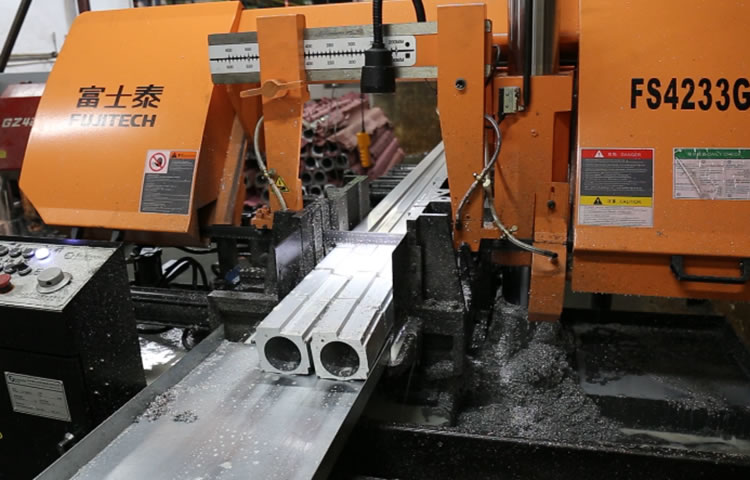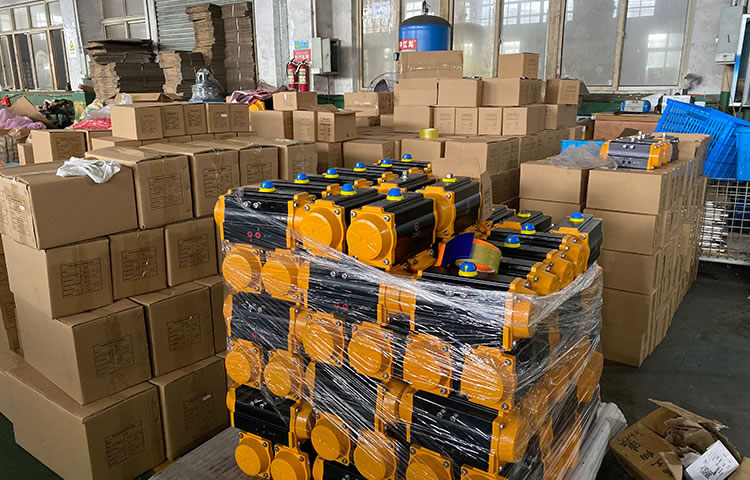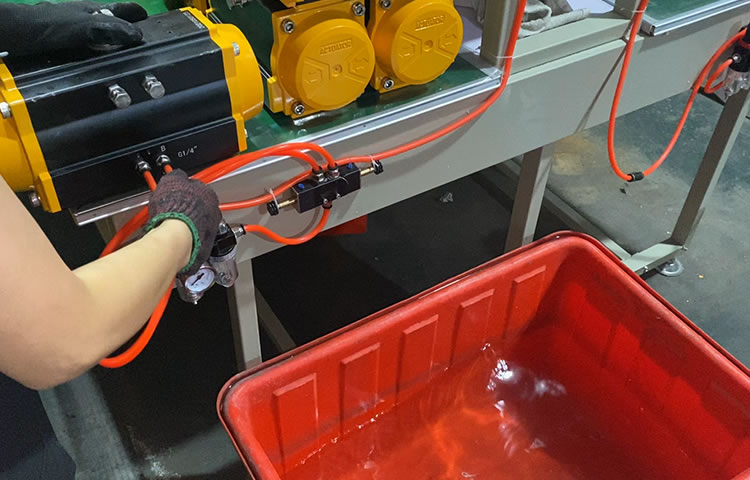Electric Ball Valve
Elevate Your Efficiency with Advanced Pneumatic Solutions.
Elevate Your Efficiency with Advanced Pneumatic Solutions.
The electric ball valve is a valve that controls the flow of fluid through the rotation of a ball driven by an electric motor.
Electric ball valves present remarkable control and dependability in the realm of industrial process control applications. Their distinct design enables the efficient modulation of flow rate and pressure, all while expending less energy in comparison to conventional valves. Motorized ball valves can be furnished with PTFE or FKM lining, endowing them with outstanding chemical resistance and corrosion protection that surpasses that of standard metal valves. Additionally, their self-lubricating property ensures a more seamless operation and demands less upkeep than other valve varieties. These motorized ball valves are well-suited for a diverse range of industrial applications, including shutoff, throttling, or regulating functions in oil refineries, water treatment facilities, and chemical plants. Invest in an electrically actuated ball valve today and relish the excellent outcomes it brings.
Electrically actuated ball valves represent a particular class of valves that are employed for governing the flow of liquids or gases across a wide spectrum of industries. These encompass plumbing, manufacturing, food and beverage processing, energy production, pharmaceuticals, and numerous other sectors. These valves are engineered to afford precise control using electric actuators that execute electrically powered rotary motion to either open or close the valve. Consequently, they possess several benefits in contrast to manually operated valves, especially in scenarios where recurrent on/off cycles take place or when automation is a requisite.
Electrically actuated ball valves deliver outstanding performance, thanks to their remarkable tight shut-off capability. This enables them to effectively prevent leaks even when subjected to extreme pressure conditions, a feat that manually operated valves simply cannot achieve due to their dependence on human operation.
Moreover, these valves offer additional advantages. Their sealed lubrication systems enhance their longevity and durability by averting potential contamination within the mechanism. Additionally, they possess the ability to control the flow rate in an adjustable manner. This is accomplished by altering the power levels of the actuator along with the utilization of precision feedback loops. As a result, electrically actuated ball valves are highly suitable for sensitive applications that demand precise process parameters and strict tolerances.
Finally, since electrically actuated ball valves demand less maintenance compared to manual ones, they can help save unforeseen capital costs while facilitating a more efficient overall system operation. This is yet another characteristic that renders these versatile pieces of equipment ideal not only for a wide variety of industries but also for different temperature extremes, which numerous machines are bound to face when operating outdoors.
In summary, ball valves equipped with electric actuators offer accurate flow regulation and full automation without compromising on safety or durability. All of this comes at a manageable cost of ownership. What more could one ask for?
Electric actuator ball valves and electric butterfly valves are both utilized for managing the flow of liquids, gases, and other substances in industrial settings. Although they might seem to have comparable functions, there exist several crucial distinctions between these two valve varieties.
When aiming to ensure maximum performance from each type of powered valve unit, it’s essential to bear your application parameters in mind. Motor-operated ball valves provide better resistance against higher pressures. However, they demand greater force or torque from the actuator.
In addition, while butterfly valves are unable to meet the same pressure ratings as ball valves, they also face limitations regarding maximum temperature thresholds and viscosities. Under certain conditions, these factors could make them unfit for use.
All these considerations will guarantee a reliable service life and optimal performance from the valve you choose. This is thanks to the combination of proper sizing, the selection of suitable materials, and the establishment of an adequate automation protocol for each unit, depending on the specific requirements of the application.
When selecting a ball valve with an electric actuator, you must consider both the electric actuator and the ball valve.
Voltage requirements. AC AC380V, AC220V, AC24V, frequency 50 Hz. DC24V, DC48V. The wiring of electric devices with different voltages is different. It is necessary to pay attention to selecting the appropriate voltage.
Working environment conditions. Ambient temperature: -10℃~55℃, or -20℃~60℃, or -30℃~70℃. Relative humidity: no more than 95%. Atmospheric pressure: 86 kPa ~ 106 kPa. Pay attention to working in a high-temperature, low-temperature environment, or high-humidity environment. Consider installing a space heater in low-temperature environments.
Enclosure protection level. The protection level of ordinary electrical equipment enclosures is not lower than IP65. Intelligent electrical equipment is no less than IP67. The first number 6 indicates a dust-tight enclosure that does not allow any dust to enter. The second number 5 means protection against water spray, 6 means protection against strong water spray, 7 means protection against short-term water immersion, and 8 means protection against continuous diving.
Corner travel time. Generally, the 90° turning time is about 30 seconds. As the diameter of the ball valve changes, the opening and closing time of the electric installation will be slightly different. The opening and closing time of electric ball valves is generally slower than that of pneumatic ball valves. Therefore, pneumatic ball valves are generally used for quick-cut-off ball valves.
Switch type and regulating type. For switch-controlled electric ball valves, the electric device should be of the switch type. For electric regulating ball valves, the electric adjustment type is selected. The adjustment signal is generally 4-20Ma or 1-5V. When the signal is interrupted, there will be a signal to maintain the position, fully open, and fully closed. Three states are available.
Whether explosion-proof is required. When the medium or environment in the pipeline involves explosion protection, explosion-proof electric devices need to be used. The explosion-proof type is d, the category is Class II, the explosive gas mixture is Class A, B, and C, and the maximum allowable surface temperature is T4~T6. dI is suitable for non-mining working faces in coal mines.
Electric O-shaped ball valve. Used for pipeline switch control, and good sealing, and can be used for gas and liquid pipelines.
Electric V-shaped regulating ball valve. Its V-shaped incision has left and right shear, and is suitable for media containing fibers, particles, slurry, and other media. It has good blocking resistance and the adjustable ratio can reach 100:1. Equipped with adjustable electrical equipment.
Stainless steel electric ball valve. In acid and alkali media in chemical pipelines, austenitic stainless steel electric ball valves, 304, 304L, 316, 316L, 2205, etc., should be used. The valve seat is polytetrafluoroethylene.
Fully welded electric ball valve. Used in oil and natural gas transmission pipelines, urban heating, and hot water pipelines. Effectively avoid media leakage.
Microelectronic ball valve. For use in HVAC system fan coil units. Low pressure and small diameter pipeline, low cost.
Electric hard-sealing ball valve. Suitable for high-temperature pipelines in electric power, petrochemical,l, and metallurgical systems, metal valve seats have high-temperature resistance, and wear resistance.
Electric cryogenic ball valves, electric oxygen ball valves, electric lifting rod ball valves, and electric insulation ball valves can be selected according to different working conditions.
With the development of industrial automation, miniaturization, digitalization, and intelligent integrated electric devices are constantly updated, and the application of electric ball valves will surely become more widespread.





Based on a wealth of experience, YUECHI has the knowledge to provide reliable and appropriate automotive solutions for valve applications. General technical attributes for product selection include:







